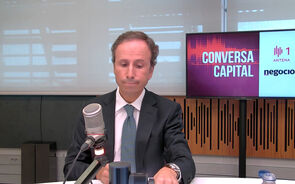David Nichols Morning Report
1 Mensagem
|Página 1 de 1
David Nichols Morning Report
FRIDAY a.m.
January 17, 2003
The Red QQV
by David Nichols
I often talk about the VIX, which is the Volatility Index on the S&P 100 (OEX), which used to be the biggest options market around. The VIX is a real-time calculation based on the prices of calls and puts that are at-the-money, and it's a great tool for gauge how traders are spending their money in the real world. They are showing us how they "feel" about the market by what they are spending money on.
When the VIX is rising, traders are willing to pay-up for puts, as they feel the market is on the verge of a tumble. When the VIX is falling, it's telling us that the market makers have to keep adjusting the price of puts down in order to entice put buyers into the market. There isn't a lot of fear.
While the OEX remains a big, liquid options market, it's been dwarfed in size now by options on the QQQ, the immensely popular proxy for the Nasdaq 100. On a typical day, a few hundred thousand QQQ options will trade. QQQ options are cheap and liquid, and this is the place where most retail investors -- and many institutional traders -- go to play the market.
Not many know that the AMEX keeps track of the implied volatility on the QQQ with its own version of the VIX, called the QQV. This is just like a VIX on the QQQ, and it's a very valuable sentiment tool in its own right.
A first look at the QQV reveals something extremely strange. Nearly every single candle is red!
A red candle means that the open is higher than the close. The top of the body of the candle is the opening price, and the bottom of the body of the candle is the closing price.
A red candle on a volatility index shows that in the morning the market makers are raising the prices on puts and calls -- which they are selling to that fresh batch of buy orders in the morning -- and in the afternoon they are lowering the prices, so they can buy them back with a nice little profit on the premium component of the options price. Well it's nice for them, anyway.
Remember, a declining QQV is associated with market participants feeling more bullish about the prospects for the QQQ. So lately the bullishness has been rising. The funny thing is, the bullishness has been rising lately while the QQQ itself has been stumbling quite badly.
That's a highly bearish sentiment divergence. If the decline we have seen over the past few sessions -- a 4.6% loss in the QQQ -- isn't enough to make people fearful of further declines, then what will be? The answer to that question is much bigger declines in price. It shows a dangerous surplus of bullishness in the QQQ.
Another nifty way to use the QQV is to keep a lookout for that all-too-rare white candle. This shows true fear has been released into the market, and the market makers are not able to play their customary price-markdown-game into the overwhelming demand for puts.
A white candle on the QQV is a highly reliable predictor of a further rise in the QQV, and further declines in price. Even more predictive is a white weekly candle, which shows the potential for a much bigger overall market decline.
Going back a bit on the QQV, we can see that the current level is associated with past tops in the QQQ. It's also possible that a little rise in the QQV today will form a white weekly candle. Let's keep an eye on this, as that will be a very bearish sign for the next few weeks, at the very least. All of the serious declines in the QQQ kick off with white weekly candles from these levels in the 30s.
January 17, 2003
The Red QQV
by David Nichols
I often talk about the VIX, which is the Volatility Index on the S&P 100 (OEX), which used to be the biggest options market around. The VIX is a real-time calculation based on the prices of calls and puts that are at-the-money, and it's a great tool for gauge how traders are spending their money in the real world. They are showing us how they "feel" about the market by what they are spending money on.
When the VIX is rising, traders are willing to pay-up for puts, as they feel the market is on the verge of a tumble. When the VIX is falling, it's telling us that the market makers have to keep adjusting the price of puts down in order to entice put buyers into the market. There isn't a lot of fear.
While the OEX remains a big, liquid options market, it's been dwarfed in size now by options on the QQQ, the immensely popular proxy for the Nasdaq 100. On a typical day, a few hundred thousand QQQ options will trade. QQQ options are cheap and liquid, and this is the place where most retail investors -- and many institutional traders -- go to play the market.
Not many know that the AMEX keeps track of the implied volatility on the QQQ with its own version of the VIX, called the QQV. This is just like a VIX on the QQQ, and it's a very valuable sentiment tool in its own right.
A first look at the QQV reveals something extremely strange. Nearly every single candle is red!
A red candle means that the open is higher than the close. The top of the body of the candle is the opening price, and the bottom of the body of the candle is the closing price.
A red candle on a volatility index shows that in the morning the market makers are raising the prices on puts and calls -- which they are selling to that fresh batch of buy orders in the morning -- and in the afternoon they are lowering the prices, so they can buy them back with a nice little profit on the premium component of the options price. Well it's nice for them, anyway.
Remember, a declining QQV is associated with market participants feeling more bullish about the prospects for the QQQ. So lately the bullishness has been rising. The funny thing is, the bullishness has been rising lately while the QQQ itself has been stumbling quite badly.
That's a highly bearish sentiment divergence. If the decline we have seen over the past few sessions -- a 4.6% loss in the QQQ -- isn't enough to make people fearful of further declines, then what will be? The answer to that question is much bigger declines in price. It shows a dangerous surplus of bullishness in the QQQ.
Another nifty way to use the QQV is to keep a lookout for that all-too-rare white candle. This shows true fear has been released into the market, and the market makers are not able to play their customary price-markdown-game into the overwhelming demand for puts.
A white candle on the QQV is a highly reliable predictor of a further rise in the QQV, and further declines in price. Even more predictive is a white weekly candle, which shows the potential for a much bigger overall market decline.
Going back a bit on the QQV, we can see that the current level is associated with past tops in the QQQ. It's also possible that a little rise in the QQV today will form a white weekly candle. Let's keep an eye on this, as that will be a very bearish sign for the next few weeks, at the very least. All of the serious declines in the QQQ kick off with white weekly candles from these levels in the 30s.
1 Mensagem
|Página 1 de 1
Quem está ligado:
Utilizadores a ver este Fórum: PAULOJOAO e 94 visitantes


